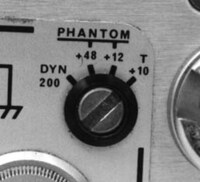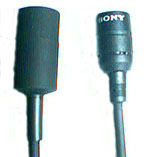 The topic for this article is mic powering, including Nagra "red dotting" and other basics pertaining to "phantom" powering of mics. If you are already intimately familiar with such terms as: T-powering; A-B powering; phantom powering; electret condenser; QPM 3-5; QPAU-T; and phasing cables -- then give yourself an A and skip on to another article in this website. But if any of this talk strikes you as resembling a call sheet from a sci-fi epic, then this primer is for you.
The topic for this article is mic powering, including Nagra "red dotting" and other basics pertaining to "phantom" powering of mics. If you are already intimately familiar with such terms as: T-powering; A-B powering; phantom powering; electret condenser; QPM 3-5; QPAU-T; and phasing cables -- then give yourself an A and skip on to another article in this website. But if any of this talk strikes you as resembling a call sheet from a sci-fi epic, then this primer is for you.
For the purpose of simplification, microphones will be divided into three basic categories: dynamic, condenser and electret condenser.
Dynamic microphones operate directly off of existing sound pressure. The sound waves themselves move an element (the mic diaphragm) in and out of a magnet, thus generating electric pulses (audio signals). Dynamic microphones require a fair amount of kinetic energy, which in turn makes them not as sensitive to subtle noises or faint sounds.
On the other hand, because they are so mechanically simple and durable -- dynamics are ideal to use in loud-noise situations, such as the recording of explosions. Used close to the mouth in a loud background situation, they will deliver a surprisingly clean voice track.
Dynamic microphones do not require any sort of external powering. Just connect them directly to a microphone level input and they are ready for use.
The next division of microphone power is electret condenser. Without getting too technical, this class of microphone employs a lightly charged electro-magnetic element. Whereas the dynamic microphone operates sort of like a generator, creating electrical impulses by passing a coil through a magnet, the electret condenser is more of a capacitor. That is, it varies the flow of an existing electric current based on actions caused by sound pressure. Think of dynamic microphones as manual typewriters, and electret condensers as office electric typewriters. The microphone does not have to generate electricity but rather just dispenses it.
The electret condenser class are considerably more sensitive to sound and can be made somewhat directional. For the most part, electrets work off of approximately 1.5 volts of DC current and draw very little power.
Powering for these mics is usually supplied via a built-in battery supply, found either in the "handle" of the mic or in the connector.
 Virtually all of your professional lavaliers are of the electret condenser variety, such as: the Sony ECM44, ECM55; the MiniMic; the Tram TR50; Countryman EMW & B6, Audio Technica AT803 & AT899, and the Sennheiser MKE2. Most of these mics simply take one AA battery. The others, such as the TRAM, take one variety or another of a silver-oxide "button" battery (often located in an in-line plastic housing near the connector). When these mics are used as radio mics, they take their powering directly from the bodypack transmitter rather than their own bulky power supplies. As a convenience, some of these lavs can also be powered by Phantom power provided by mixing boards or some recorders.
Virtually all of your professional lavaliers are of the electret condenser variety, such as: the Sony ECM44, ECM55; the MiniMic; the Tram TR50; Countryman EMW & B6, Audio Technica AT803 & AT899, and the Sennheiser MKE2. Most of these mics simply take one AA battery. The others, such as the TRAM, take one variety or another of a silver-oxide "button" battery (often located in an in-line plastic housing near the connector). When these mics are used as radio mics, they take their powering directly from the bodypack transmitter rather than their own bulky power supplies. As a convenience, some of these lavs can also be powered by Phantom power provided by mixing boards or some recorders.
Most of the modular, screw-on capsule microphone systems are also of the electret type. A prime example is the Sennheiser K6 series (ME62 omni, ME64 cardioid, ME66 hypercardioid) that is so popular among video crews. At the heart of the system is the K6 battery supply/pre-amp, which utilizes an AA camera battery or remote Phantom power.
Another extremely popular electret condenser shotgun mic is the Audio Technica AT897. Though it is not modular, it is one of the top selling mics for video production, and powers from either an AA battery or remote Phantom power.
Very rarely does a battery go dead due to normal use. Most microphone manufacturers claim an estimated continuous working life of 1,500 to 3,000 hours per single battery. That’s at least two solid months or longer, even if you never take the battery out at the end of the day.
The most common cause of electret microphone failure is that the battery was installed backwards, or that no battery was installed at all. Sometimes, one of the battery contacts might only need some polishing (a crisp dollar bill works very well for that purpose).
Since electret condensers have their own battery supplies, they can be treated the same as dynamics as far as connecting them to a microphone level input is concerned. Just plug them in.
The third category of microphones, and the group that accounts for the most confusion regarding powering, is that of the RF condenser.
